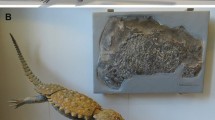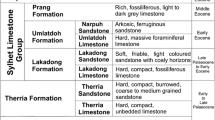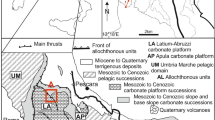Summary
Late Eocene sediments of the Upper Austrian Alpine Foreland Basin discordantly overlie Mesozoic and crystalline rocks, which are deeply eroded and form a distinct pre-Eocene relief. Late Eocene deposits contain red algal limestones with a remarkable lateral extent and a high diversity of sedimentary facies. Towards the south the algal limestones change into more clastic sediments, which are characterized by larger foraminifera and bryozoans. Main components are coralline algal branches and detritus, coralline crusts, rhodoliths, peyssonneliacean aggregates and crusts, nummulitid and orthophragminid foraminifera, corals, bryozoans, as well as terrigenous components.
Rank correlation and factor analysis were calculated in order to obtain informations about relations between components. Hierarchical cluster analysis allowed the designation of 17 facies, most of them are dominated by coralline algae. Actualistic comparisons and correlations obtained from statistical analyses allowed the reconstruction of the depositional environments.
Main features of the northern area are huge accumulations of unattached coralline algae (branches, rhodoliths, detritus), which are comparable to the present-day “Maerl”-facies. They formed loose frameworks cut by sand channels. The frequency of coralline detritus decreases upsection. Peyssonneliacean algae in higher parts of the profiles show growth-forms that are comparable to peyssonneliaceans of the Mediterranean circalittoral soft bottoms. This succession can be interpreted by an increasing relative sea level. Besides, crustose coralline algal frameworks were growing on morphological highs which are partially comparable to the present-day “Coralligéne de Plateau” of the Mediterranean Sea.
In contrast to the northern area, sedimentation rate of the southern area is too low to keep up with rising sea level. The typical succession from nummulitid- to orthophragminid-and bryozoan-dominated facies can be interpreted by an increasing water depth from shallowest subtidal to the deeper photic zone and finally to the aphotic zone.
Similar content being viewed by others
References
Aberer, F. (1958): Die Molassezone im westlichen Oberösterreich und in Salzburg.—Mitt. Geol. Ges. Wien50/1957, 23–93, Wien
Adey, W.H. (1978): Algal ridges of the Caribbean sea and West Indies.—Phycologia17/4, 361–367, Lawrence
Adey, W.H. (1986): Coralline algae as indicators of sea-level.—In:Plasche, O. van de (ed.): Sea-level research: a manual for the collection and evaluation of data.—229–280. Norwich (Geo-Books)
Adey, W.H. &Burke, R. (1976): Holocene bioherms (algal ridges and bank-barrier reefs) of the eastern Caribbean.—Geol. Soc. Amer. Bull.87, 95–109, Boulder
Adey, W.H. &Maciniyre, I.G. (1973): Crustose coralline algae: A re-evaluation in the geological sciences.—Geol. Soc. Amer. Bull.84, 883–904, Boulder
Baccelle, L. &Bosellini, A. (1965): Diagrammi per la stima visiva della composizione percentuale nelle rocce sedimentarie. —Ann. Univ. Ferrara, N.S., Sez. IX, Sci. Geol. Paleont.1/3, 59–62, Ferrara
Bassi, D. (1997): Vegetative anatomy and paleoecology ofPolystrata alba (Pfender) Denizot, 1968 (cryptonemiales, Peyssonneliaceae) from the Upper Eocene of northern Italy.— Rev. Paléobiol.16/2, 309–320, Genève
Bassi, D. (1998): Coralline algal facies and their palaeoenvironments in the Late Eocene of Northern Italy (Calcare di Nago, Trento).— Facies39, 179–202, Erlangen
Basso, D. (1990): The calcarcous algaPeyssonnelia rosa-marina Boudouresque & Denizot, 1973 (Rhodophyceae, Peyssonneliaceae) in circalitoral soft bottoms of Tyrrhenian Sea.— Quad. Civ. Staz. Idrobiol.17, 89–106
Blind, W. (1965): Der Lithothamnienkalk der ostbayerischen Molasse und seine Eigenschaften als Trägergestein.—Erdoel-Erdgas-Z.17, 341–345, Wien
Bonye, Y. &James, N.P. (1993): Bryozoans as carbonate sediment producers on the cool-water Lacepede Shelf, southern Australia. —Sedim. Geol.86, 93–98, Amsterdam
Bosellini, A. &Ginsburg, R.N. (1971): Form and internal structure of recent algal nodules (Rhodolites) from Bermuda.—Journ. Geol.79, 669–682, Chicago
Bosence, D.W.J. (1983a): Description and classification of Rhodoliths.—In:Peryt, T. M. (ed.). Coated Grains.—217–224, Berlin-Heidelberg (Springer)
Bosence, D.W.J. (1983b): The occurrence and ecology of recent rhodoliths.—In:Peryt, T.M. (ed.) Coated grains.—225–242, Berlin (Springer)
Bosence, D.W.J. (1983c): Coralline algae from the Miocene of Malta.—Palaeontology26/1, 147–173, London
Bosence, D.W.J. (1983d): Coralline algal reef frameworks.—J. geol. Soc. London140, 365–376, London
Bosence, D.W.J. (1984): Construction and preservation of two modern coralline algal reefs. St. Croix, Caribbean.— Palaeontology27/3, 549–574, London
Bosence, D.W.J. (1985a): The “Coralligène” of the Mediterranean —a recent analog for Tertiary coralline algal limestones.—In:Toomey, D.F. &Nitecki, M.H. (ed.): Paleoalgology.—216–225, Berlin (Springer)
Bosence, D.W.J. (1985b): Preservation of coralline-algal reef frameworks.—Proc. 56th Int. Coral Reef Congr., Tahiti6, 623–628, Tahiti
Bosence, D.W.J. (1991): Coralline algae: mineralization, taxonomy and palacoecology.—In:Riding, R. (ed.): Calcareous algae and stromatolites.—98–113 Heidelberg (Springer)
Bosence, D.W.J. &Pedley, H.M. (1982): Sedimentology and palaeoecology of a Miocene coralline algal biostrome from the Maltese Islands.—Palaeogeogr. Palaeoclimatol. Palaeoecol.38, 9–43, Amsterdam
Braga, J.C. &Martin, J.M. (1988): Neogene coralline algal growth-forms and their palaeoenvironments in the Almanzora river valley (Almeria, S. E. Spain).—Palaeogeogr. Palaeoclimatol. Palaeoecol.67, 285–303, Amsterdam
Brix, F. &Schultz, O. (1993, eds.): Erdöl und Erdgas in Österreich. —688 p., Wien (Naturhistorisches Museum)
Buchbinder, B. &Halley, R.B. (1985): Occurence and Preservation of Eocene Squamariacean and Coralline Rhodoliths: Eua, Tonga.—In:Toomey, D.F. &Nitecki, M.H. (ed.): Paleoalgology. —248–256, Berlin (Springer)
Buchholz, P. (1984): Sedimentation und Diagenese des Lithothamnienkalkes der ostbayerischen Molasse.—Unpubl. Ms. Thesis, 146 p., Braunschweig (Technical University)
Buchholz, P. (1989): Der Lithothamnienkalk Südostbayerns. Sedimentologie und Diagenese eines Erdgasträgers.—Geol. Bav.93, 5–97, München
Bühl, A. & Zöfel, P. (1996): SPSS für Windows Version 6.1— Praxisorientierte Einführung in die moderne Datenanalyse.— 671 p., Bonn
Burkhard, M. & Sommaruga, A. (1998): Evolution of the western Swiss Molasse basin: Structural relations with the Alps and the Jura belt.—In:Mascle, A., Puigdefabregas, C., Luterbacher, H.P., & Fernandez, M. (eds.): Cenozoic foreland basins of Western Europe.—Geol. Soc. Spec. Publ.134, 279–298, London
Cosovic, V. & Drobne, K. (1998): Lutetian Orthophragminae from the Istrian peninsula (Croatia and Slovenia).—In:Hottinger, L. & Drobne, K. (eds.): Paleogene shallow benthos of the Tethys, 2.—Acad. Sci. Art. Slov., Cl. IV: Hist. Nat.34/2, 173–182, Ljubljana
Darga, R. (1992): Geologie, Paläontologie und Palökologie der südostbayerischen unterpriabonen (Ober-Eozän) Riffkalk-vorkommen des Eisenrichtersteins bei Hallthurm (Nördliche Kalkalpen) und des Kirchbergs bei Neuberern (Helvetikum).— Münchn. Geowiss. Abh. (A)23, 1–166, München
Darga, R. (1993): Bemerkenswerte Wuchsformen der ForaminifereGypsina lnearis (Hanzawa, 1945) aus der Karbonatrampe des Eisenrichtersteins bei Hallthurm (Ober-Eozän, Bayern, Nördliche Kalkalpen).—Zitteliana20, 253–361, München
Davis, J.C. (1973): Statistical and Data Analysis in Geology.—550 p., New York (Wiley)
Dean, W.E. &Eggleston, J.R. (1975): Comparative anatomy of marine and freshwater algal reefs, Bermuda and Central New York.—Geol. Soc. Amer. Bull.86, 665–676, Boulder
Dunham, R.J. (1962): Classification of carbonate rocks according to depositional texture.—Mem. Amer. Ass. Petrol. Geol.1, 108–121, Tulsa
Embry, A.F. &Klovan, J.E. (1972): Absolute water depth limits of Late Devonian paleoecological zones.—Geol. Rdschau61, 672–686, Stuttgart
Flügel, E. (1982): Microfacies analysis of limestones.—633 p., Berlin (Springer)
Freiwald, A. (1994): Sedimentological and biological aspects in the formation of branched rhodoliths in northern Norway.— Beitr. Paläont. Österr.20, 7–19, Wien
Freiwald, A., Henrich, R., Schäfer, P. &Wilkomm, H. (1991): The significance of high-boreal to subarctic maerl deposits in Northern Norway to reconstruct Holocene climatic changes and sea level oscillations.—Facies25, 315–340, Erlangen
Füchtbauer, H. (1964): Sedimentpetrographische Untersuchungen in der älteren Molasse nördlich der Alpen.—Eclogae geol. Helv.57, 157–298, Basel
Ginsburg, R.N. &Schroeder, J.H. (1973): Growth and submarine fossilization of algal cup reefs, Bermuda.—Sedimentology20, 575–614, AmsterdamHohenegger, J. (1994): Distribution of living Larger Foraminifera NW of Sesoko-Jima, Okinawa, Japan.—Mar. Ecol.15/3/4, 291–334, Berlin
Hohenegger, J. (1995): Depth estimation by proportions of living larger foraminifera.—Mar. Micropal.26, 31–47, Amsterdam
Hohenegger, J., Yordanova, E., Nakano, Y. &Tatzretter, F. (1999): Habitats of larger foraminifera on the upper reef slope of Sesoko Island, Okinawa, Japan.—Mar. Micropal.36, 109–168, Amsterdam
Horowitz, A.S. &Potter, P.E. (1971): Introductory Petrography of Fossils.—302 p., Berlin (Springer)
Hottinger, L. (1983): Processes determing the distribution of larger foraminifera in space and time.—Utrecht Micropal. Bull.30, 239–254, Utrecht
Janoschek, R. (1964): Das Tertiär in Österreich.—Mitt. Geol. Ges.56/2, 320–360, Wien
Janoscheck, R. &Gotzinger, K.G. (1969): Exploration for oil and gas in Austria.-Proc.: The exploration for petroleum in Europe and North Africa, 161–180, London (Institute of Petroleum)
Koba, M. (1978): Distribution and environment of recenCycloclypes.—Sci. Rep. Tohoku Univ., 7th Ser. (Geogr.)28/2, 283–311, Tohoku
Kollmann, K. (1966): Die Mächtigkeitsverteilung der Ablagerungen des Obereozäns und tiefen Rupelsals Grundlage für eine Rekonstruktion der frühen Baugeschichte des Ölfeldes Ried (Molassezone Oberösterreich).—Erdöl-Erdgas-Zeitschrift82/5, 175–185, Wien
Kollmann, K. (1977): Die Öl- und Gasexploration der Molassezone Oberösterreichs und Salzburg aus regional-geologischer Sicht.—Erdoel-Erdgas-Z.93, 36–49, Wien
Kröll, A., Schimunek, K. &Wessely, G. (1981): Ergebnisse und Erfahrungen bei der Exploration in der Kalkalpenzone in Österreich.—Erdoel-Erdgas-Z.97, 134–148, Wien-Hamburg
Less, G. (1987): Paleontology and stratigraphy of the European Orthophragminae.—Geologica Hungarica51, 1–373, Budapest
Littler, M.M., Littler, D.S. &Hanisak, M.D. (1991): Deep-water rhodolith distribution, productivity, and growth history at sites of formation and subsequent degradation.—Journ. Mar. Biol. Ecol.150, 163–182, Amsterdam
Macgregor, A.R. (1983): The Waitakere Limestone, a temperate algal carbonate in the lower Tertiary of New Zealand.—J. geol. Soc.140, 387–399, London
Miall, A.D. (1973): Markov chain analysis applied to an ancient alluvial plain succession.—Sedimentology20, 347–364, Amsterdam
Murray, J.W. (1987): Benthic foraminiferal assemblages-criteria for the distinction of temperate and subtropical carbonate environments.—In:Hart, M. (ed.): Micropaleontology of carbonate environments.—9–19, Berlin (Springer)
Nachtmann, W. &Wagner, L. (1987): Mesozoic and Early Tertiary evolution of the Alpine foreland in Upper Austria and Salzburg, Austria.—Tectonophysics,137/1–4, 61–76, Amsterdam
Oberhauser, R. (1995): Zur Kenntinis der Tektonik und der Paläogeographie des Ostalpenraumes zur Kreide-, Paleozän- und Eozänzeit.—Jahrb. Geol. Bund. Anst.138/2, 369–432, Wien
Papp, A. (1958): Vorkommen und Verbreitung des Obereozäns in Österreich.—Mitt. Geol. Ges.50, 251–270, Wien
Purnachandra Rao, V., Lamboy, M. &Dupeuble, P.A. (1993): Verdine and other associated authigenic (glaucony, phosphate) facies from the surficial sediments of the southwestern continental margin of India.—Mar. Geol.111, 133–158, Amsterdam
Rasser, M. (1994): Facies and palaeoecology of rhodoliths and acervulinid macroids in the Eocene of the Krappfeld (Austria).—Beitr. Paläont.19, 191–217, Wien
Rasser, M.W. (1999): Fazies und Paläoökologie der obereozänen Rotalgenkalke der oberösterreichischen Molassezone.—Unpubl. Ph. Thesis, 204 p., Vienna (University of Vienna)
Rasser, M.W. &Piller, W.E. (1999): Application of neontological taxonomic concepts to Late Eocene coralline algae (Rhodophyta) of the Austrian Molasse Zone.—Journ. of Micropal.18(1): 67–80, London
Reading, H.G. (1986): Sedimentary environment and facies.—615 p., Oxford (Blackwell)
Reid, R.P. &Macintyre, I.G. (1988): Foraminiferal-algal nodules from the Eastern Caribbean: Growth history and implications on the value of nodules as paleoenvironmental indicators.—Palaios3, 424–435, Lawrence
Scoffin, T.P. (1988): The environments of production and deposition of calcareous sediments on the shelf west of Scotland.—Sedim. Geol.60, 107–134, Amsterdam
Scoffin, T.P., Stoddart, D.R., Tudhope, A.W. &Woodroffe, C. (1985): Rhodoliths and coralliths of Muri Lagoon, Rarotonga, Cook Islands.—Coral Reefs4, 71–80, Berlin
Sinclair, H.D., Sayer, Z.R. &Tucker, M.E. (1998): Carbonate sedimentation during early foreland basin subsidence: the Eocene succession of the French Alps.—In:Wright, V.P. &Burchette, T.P. (eds.): Carbonate Ramps.—Geol. Soc. Spec. Publ.149, 205–228, London (Geological Society)
Smith, A.M. (1994): Palaeoenvironmental interpretation using bryozoans: a review.—In:Bosence, D.W.J. (ed.): Marine Palaeoenvironmental Analysis from Fossils.—Geol. Soc. Spec. Publ.,83, 231–243, London (Geological Society)
Steininger, F.F., Wessely, G., Rögl, F. &Wagner, L. (1986): Tertiary sedimentary history and tectonic evolution of the Eastern Alpine Foredeep.—Giorn. Geol., ser. 348/1–2, 285–297, Bologna
Steneck, R.S. (1985): Adaptions of Crustose Coralline Algae to Herbivory: Patterns in Space and Time.—In:Toomey, D.F. &Nitecki, M.H. (eds.): Paleoalgology.—352–366, Berlin (Springer)
Steneck, R.S., Macintyre, I.G. &Reid, R.P. (1997): A unique algal ridge system in the Exuma Cays, Bahamas.—Coral Reefs16, 29–37, Berlin
Swan, A.R.H. & Sandiland, M. (1995): Introduction to Geological Data Analysis.—466 p., Oxford
Thornton, S., Pilkey, O. &Lynts, G. (1978): A lagoonal crustose coralline algal micro-ridge: Bahiret el Bibane, Tunisia.—Journ. Sedim. Petrol.48, 743–750.
Ungaro, S. (1996): Adaptive morphological strategy ofGypsina (encrusting Foraminifer).—In:Cherchi, A. (ed.): Autecology of selected fossil organisms: Achievements and problems.—Boll. Soc. Paleont. Ital., Spec. Vol.3, 233–241, Modena
Wagner, L. (1980): Geologische Charakteristik der wichtigsten Erdöl- und Erdgasträger der oberösterreichischen Molasse, Teil I: Die Sandsteine des Obereozäns.—Erdöl Erdgas Z.96/9, 338–346, Wien
Wagner, L. (1996): Stratigraphy and hydrocarbons in the Upper Austrian Molasse Foredeep (active margin).—In:Wessely, G. & Liebl, W. (eds.): Oil and gas in Alpidic thrustbelts and basins of Central and Eastern Europe.—Europ. Assoc. Geosci. Engin. Spec. Publ.5, 217–235, London
Wagner, L.R. (1998): Tectono-stratigraphy and hydrocarbons in the Molasse Foredeep of Salzburg, Upper and Lower Austria. —In:Mascle, A., Puigdefabregas, C., Luterbacher, H.P. & Ferndandez, M. (eds.): Cenozoic foreland basins of Western Europe.—Geol. Soc. Spec. Publ.134, 339–370, London
Wagner, L., Kuckelkorn, K. &Hiltmann, W. (1986): Neue Ergebnisse zur alpinen Gebirgsbildung Oberösterreichs aus der Bohrung Oberhofen 1-Stratigraphie, Fazies, Maturität und Tektonik.—Erdöl-Erdgas Z.102/1, 12–19, Wien
Wehrmann, A., Freiwals, A. &Zankl, H. (1995): Formation of cold-temperate water multispecies rhodoliths in intertidal gravel pools from Northern Brittany, France.—Senckenbergiana maritima26/1/2, 51–71, Frankfurt
Wessely, G. (1987): Mesozoic and Tertiary evolution of the Alpine-Carpathian foreland in eastern Austria.—Tectonophysics137, 45–59, Amsterdam
Zágorsek, K. (1996): Paleoecology of the Eocene bryozoan marl in the Alpine-Carpathian region.—In:Gordon, D.P., Smith, A.M. & Grant-Mackie, J.A. (eds.): Bryozoans in space and time.—Proc. 10th Int. Bryozoology Conf., 413–422, Wellington
Ziegler, P.A. (1987): Late Cretaceous and Cenozoic intra-plate compressional deformations in the Alpine foreland—a geodynamic model.—Tectonophysics137, 389–420, Amsterdam
Zweigel, J., Aigner, T. & Luterbacher, H.P. (1998): Eustatic versus tectonic controls on Alpine foreland basin fill: Sequence stratigraphy and subsidence analysis in the SE German Molasse.—In:Mascle, A., Puigdefabregas, C., Luterbacher, H.P. & Fernandez, M. (eds.): Cenozoic foreland basins of Western Europe.—Geol. Soc. Spec. Publ.134, 299–324, London
Author information
Authors and Affiliations
Corresponding author
Rights and permissions
About this article
Cite this article
Rasser, M.W. Coralline red algal limestones of the late Eocene alpine Foreland Basin in Upper Austria: Component analysis, facies and palecology. Facies 42, 59–92 (2000). https://doi.org/10.1007/BF02562567
Received:
Revised:
Issue Date:
DOI: https://doi.org/10.1007/BF02562567




